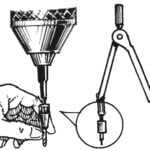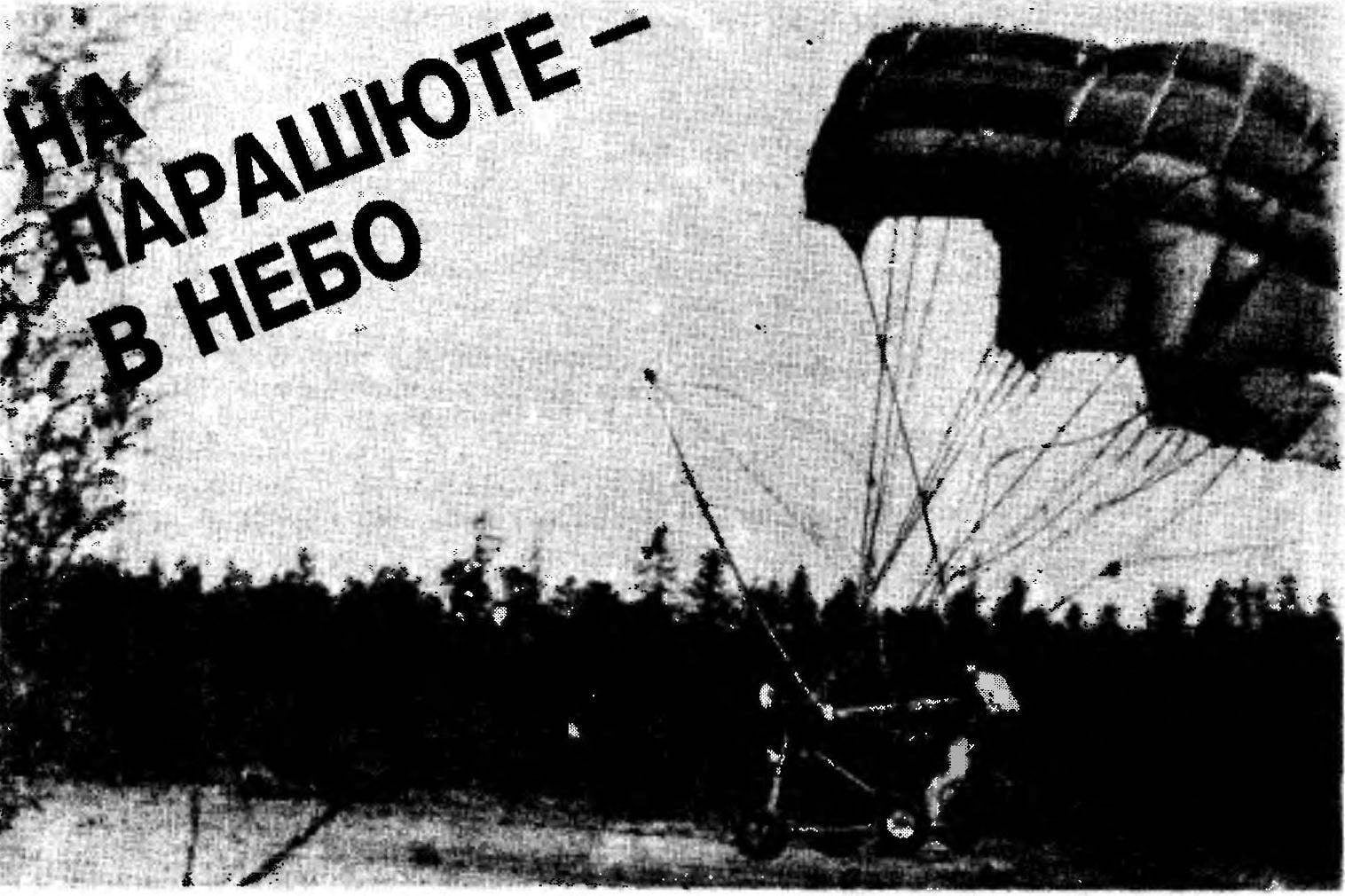Throttle control of the carburetor — foot: the sector of “gas” is set to one of the pedals (on our parapet on the right). The “stop” button remote stop the engines are located on the right and left brake control parakram. Near each of the cylinders are mounted ejectors of a thin sheet of aluminum, which improves the cooling of the engine.
Each of the engines is fixed at five points using a hard rubber cushion. The scheme of the power plant is somewhat similar to what is used on trikes “Search-5” (see No. 3, 1988), only on our parapet used chain transmission. The gear shaft shall
to have angular contact ball bearing, since the thrust creates a significant axial load. Sprocket chain gear has 19 teeth; by welding mounted on a leading helical worn-gear engine-IZH-Planeta-Sport. On the slave — 42 teeth, borrowed it from the rear wheels of the same motorcycle.
Engine start is performed using the developed by us the inertia starter, which is based on the micro KMD-2,5. The mass of the device is only half a kilogram (it is basically mass flywheel). The relay requires a fuel mixture,
consisting of 31% ether, 45% kerosene, 8% castor oil and 16% oil MS-20. KMD-2,5 and easily starts (it is necessary only to sharply turn the flywheel by hand), and develops a 10 to 12 thousand rpm. Launch engines paralite is carried out alternately by means of friction nozzle on the flywheel: it ensures contact of the rotating flywheel to the secondary shaft chain gear.
The power plant has two screws: the first — with a diameter of 1500 mm, with a pitch of 700 mm; and the second is of the same diameter, but with a step of 600mm. the Reduce step of the second screw relative to the first is caused by the effect of tightening the first screw thread. They are both made from a dry pine billet, glued together with epoxy glue up of four boards. After the final surface treatment papered fiberglass epoxy resin. To the Central hub (flange), each of the screws are fixed by bolts with nuts and washers, with mandatory locking nuts according to the methods described in No. 12 of 1988.
The fuel tank is transparent(from two-gallon plastic Jerry cans), it is located in front of the pilot, on rubber shock absorbers; fuel flows to the carburetor by gravity. If you intend to use a fuel pump,it makes sense to install the tank in the back.
The instrument panel is spring loaded — it protects it from vibration. On the dashboard mounted indicator climb rate, altimeter and temperature gauge the cylinder head (two TTT-47). Receiver air pressure (LDPE) made “whiskers”.
The pilot’s seat cut and sewn from avisenta with a foam gasket. Mounted it on the trike ribbons type Ltcr P-813-800 and are equipped with safety belts. Depending on the growth of the pilot the position of the seat can be adjusted in height. In the cold season before the pilot set the visor from
organic glass.
When debugging a machine, special attention should be given to its alignment. Indicative of the point of toe-hooks the trike to krylo shown in the diagram. But more accurately the position of points is determined after the experimental approach to a height 2…3 meters: the unit in this case is guided tan to avoid jerking paracril “mustache” — otherwise the wing can izmeniti the installation angle to negative. Characteristically, the alignment Paralela significantly affects the propeller thrust, since the trike is suspended from paracril at two points, and when Tightening the brake alignment is moved relative to the focus wing. However, a well-regulated system “paracril-trike” is quite stable and if any adverse effects quickly returns to a state of stable equilibrium.
Adjustment of the lengths of the sling is possible within certain limits to alter the wing profile. In this case the wider spaced free ends, the higher lateral stability Paralela. And adjustment of the lateral stabilizers, it is possible to make paracril resistant to stalling, and also to change the turning speed. Note that when adjusting, it is recommended to increase the length of certain rafter not more than 50 mm, checking the impact of changes in approach at a height of 1.5…2 m. Slings two front rows paracril should be strictly the same: the maximum deviation of their length — not more than 10 mm.
Adjustment of the lengths of the first row of the Central sling starts with a size of 2800 mm. With decreasing the length increases the vertical component of velocity planning, and already at a length of 2500 mm side intakes have not been filled. The side straps must be 200 mm longer main — depends on the stability of the parachute system. The sling length should be measured from the buckle half-rings to the bottom of the cloth paracril, including the length of the stabilizing sheets and kerchiefs. Correctly adjusted when planning wing has a negative angle of attack and tilted the intakes down. The difference of the lengths of the sling first and the last (sixth) row is 1 250 mm.
In the motor mode of flight (with traction) angle of attack paracril is 7…10 degrees. During takeoff and landing, this angle some more.
Adjustment of the lengths of the sling is serial outbreak of the attachment straps on the buckles of the half-rings the free ends of the harness. After verifying the length of nodes on the sling again tie a simple five-eighth-mishegoyim “Stina”, Nan is shown on one of the drawings. Further, when the length of the slings is determined, the end of it is sewn with nylon thread No. 9-13, which fully guarantees against the outbreak of such a node.
In the production of approach it must be borne in mind that the pitch control (up or down) by means of adjustment of the engine speed, and a turn — pulling the appropriate brake control.
Evgeny SHABUROV, village of T a R g o (Yakutia)
Recommend to read
 THE SECOND COMING OF THE “HYBRIDS”
THE SECOND COMING OF THE “HYBRIDS”
The emergence of nuclear submarines dramatically changed the balance of forces at sea, not only between countries but also between classes of ships. Indeed, hunters submarines could... THE UNION OF THE COMPASS AND DRILLS
THE UNION OF THE COMPASS AND DRILLS
Thin drill bits are known to clamp in the Chuck of the drill difficult. However, there is a cartridge that copes with it easily — as used in the compass. That and they need to use it....
 This motor glider (currently, such devices are often referred to paraleli), developed in the design office of the club of Amateur technical creativity “Evrika” Yakut posely Torgo, called “Carlson-4”. The figure in its name clearly indicates that this fourth version of the aircraft of this kind. Since 1985, we have been able to accumulate a lot of experience, primarily in the tow missions on our designs.
This motor glider (currently, such devices are often referred to paraleli), developed in the design office of the club of Amateur technical creativity “Evrika” Yakut posely Torgo, called “Carlson-4”. The figure in its name clearly indicates that this fourth version of the aircraft of this kind. Since 1985, we have been able to accumulate a lot of experience, primarily in the tow missions on our designs.